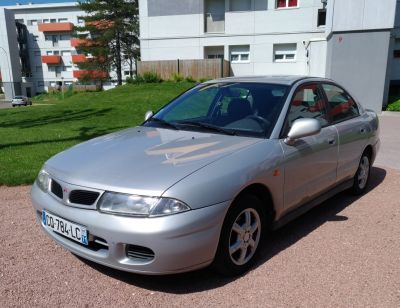 1996 Ford Mondeo I Hatchback (facelift 1996) Dimensions, Size & Specs
1996 Ford Mondeo I Hatchback (facelift 1996) Dimensions, Size & SpecsMeasurements of the 1996 Ford Mondeo I Hatchback, engineered for optimal performance and comfort
| Dimensions | |
|---|---|
| Length: | 4556 mm179.4 in14.9 ft |
| Width: | 1751 mm68.9 in5.7 ft |
| Height: | 1427 mm56.2 in4.7 ft |
| Trunk Capacity: | 450-460 liter15.9-16.2 cu ft |
| Trunk Capacity (Max): | 1290 liter45.6 cu ft |
| Weight Specifications | |
| Curb Weight: | 1240-1371 kg2734-3023 lbs |
| Maximal permitted Weight: | 1790-1870 kg3946-4123 lbs |
| Tire Specifications | |
| Rims Size: | Other Rims:
|
| Tire Sizes: |
|
The Ford Mondeo I Hatchback (facelift 1996) represents a refined iteration of Ford’s popular midsize hatchback produced from 1995 to 2001. This generation facelift brought aesthetic updates and maintained the car's appeal in the competitive family car segment. The Mondeo I Hatchback measures 4556 mm (179.4 inches) in length, 1751 mm (68.9 inches) in width, and ranges between 1424 mm to 1427 mm (56.1 to 56.2 inches) in height. These dimensions give the Mondeo a balanced and roomy stance ideal for family use and daily commuting.
Weighing between 1240 kg and 1371 kg (2734 to 3022 lbs) in curb weight, the vehicle offers a solid driving feel without being overly heavy, contributing to reasonable fuel efficiency and handling dynamics. The maximum permissible weight spans 1790 to 1870 kg (3944 to 4123 lbs), accommodating passengers and cargo with confidence.
Luggage capacity is practical, with a standard boot volume of 450 to 460 liters (15.9 to 16.2 cubic feet), which expands impressively to 1290 liters (45.5 cubic feet) when the rear seats are folded down. This flexible cargo space supports a variety of lifestyle needs, from grocery runs to weekend getaways.
The facelifted Mondeo rides on steel or alloy rims sized at 7J, fitted with tires of varying sizes including 185/65 R14, 195/65 R15, and the sportier 215/45 R17 options, contributing to both comfort and traction across different driving conditions.
Overall, the 1996 Ford Mondeo I Hatchback facelift combines practical dimensions, comfortable interior space, and adaptable luggage capacity making it a well-rounded choice in the midsize European hatchback category of its era.
Discover the standout features that make the 1996 Ford Mondeo I Hatchback a leader in its class
Have a question? Please check our knowledgebase first.
The Ford Mondeo I Hatchback (facelift 1996) measures 4556 mm (179.3 inches) in length, 1751 mm (68.9 inches) in width, and varies in height between 1424 mm and 1427 mm (56.1 to 56.2 inches). These dimensions provide a balanced profile typical for a mid-sized hatchback of its era, making it spacious enough for comfortable passenger accommodation while still being manageable for city driving and parking.
The curb weight of the 1996 Ford Mondeo I Hatchback ranges between 1240 kg and 1371 kg (2734 to 3022 pounds), depending on the specific trim and equipment. Its maximum allowable weight, which includes passengers, cargo, and the vehicle itself, ranges from 1790 kg to 1870 kg (3946 to 4123 pounds). This weight balance supports a combination of good handling characteristics and efficient fuel consumption for a mid-size hatchback.
With the rear seats in place, the Ford Mondeo I Hatchback (1996 facelift) offers a luggage capacity of 450 to 460 liters (approximately 15.9 to 16.2 cubic feet). When the rear seats are folded down, the cargo space expands significantly to about 1290 liters (45.6 cubic feet), providing ample room for transporting larger items or increased luggage during travel.
The Mondeo I Hatchback facelift version came with 7J size rims, supporting tire sizes that vary between 185/65 R14, 195/65 R15, and 215/45 R17. These varying tire sizes accommodate different performance profiles and aesthetics, enabling owners to choose between more comfort-oriented or sportier setups depending on preference.
Yes, the Ford Mondeo I Hatchback (facelift 1996), with its length of 4556 mm (179.3 inches) and width of 1751 mm (68.9 inches), fits comfortably into a typical residential garage, which usually accommodates vehicles up to about 5 meters (16.4 feet) long and 2.5 meters (8.2 feet) wide. Its moderate height between 1424 mm and 1427 mm (56.1 to 56.2 inches) also poses no issue regarding garage door clearance.
The Mondeo I Hatchback facelift is known for its well-balanced interior space offering competitive legroom and headroom for passengers, which is typical for mid-sized European family hatchbacks of the mid-1990s. Its 450 to 460 liters of boot space with seats up and an expansive 1290 liters with seats folded provide practical versatility that rivals or exceeds many competitors such as the VW Golf Mk3 or Opel Vectra of the same period.
The Mondeo I facelift of 1996 was an update of the first-generation Mondeo introduced in 1993. Dimensionally, it remained largely consistent with its predecessor; the length stayed around 4556 mm, width near 1751 mm, and height approximately 1424-1427 mm. The facelift brought mainly cosmetic and feature improvements rather than significant size changes, ensuring continuity in interior space and maneuverability.
In comparison to rivals such as the Volkswagen Golf Mk3 or Opel Vectra of the mid-1990s, the Ford Mondeo I Hatchback (facelift 1996) offers a slightly larger overall length and more boot capacity, especially with rear seats folded. It features a mid-size class footprint with a focus on practicality and comfort, positioning it as a competitive option for families needing extra space without stepping up to larger sedans or estates.
The 1996 Ford Mondeo I Hatchback facelifts targeted families and professionals seeking a practical, mid-sized vehicle with ample space for passengers and cargo. Its comfortable ride, relatively compact exterior for city and suburban use, and flexible luggage capacity made it suitable for daily commuting, family vacations, and general all-round utility.
The 1996 facelift of the Ford Mondeo I Hatchback brought refinements in exterior styling, including updated front grille, lights, and bumper design, improving the vehicle's contemporary appeal. It also introduced updated interior materials and additional equipment levels, enhancing comfort and convenience. These updates helped keep the model competitive until the next generation arrived in the early 2000s.
Discover similar sized cars.

| Production: | 1996-2002 |
|---|---|
| Model Year: | 1997 |
| Length: | 4430-4522 mm174.4-178.0 in |
| Width: | 1715 mm67.5 in |
| Height: | 1410 mm55.5 in |

| Production: | 1992-1997 |
|---|---|
| Model Year: | 1992 |
| Length: | 4520 mm178.0 in |
| Width: | 1620-1695 mm63.8-66.7 in |
| Height: | 1410 mm55.5 in |

| Production: | 1986-1994 |
|---|---|
| Model Year: | 1986 |
| Length: | 4469-4669 mm175.9-183.8 in |
| Width: | 1760 mm69.3 in |
| Height: | 1440-1490 mm56.7-58.7 in |

| Production: | 1989-1994 |
|---|---|
| Model Year: | 1987 |
| Length: | 4515 mm177.8 in |
| Width: | 1690 mm66.5 in |
| Height: | 1375 mm54.1 in |

| Production: | 2008-2010 |
|---|---|
| Model Year: | 2008 |
| Length: | 4600 mm181.1 in |
| Width: | 1800 mm70.9 in |
| Height: | 1475 mm58.1 in |

| Production: | 2009-2013 |
|---|---|
| Model Year: | 2009 |
| Length: | 4569 mm179.9 in |
| Width: | 2018 mm79.4 in |
| Height: | 1462 mm57.6 in |

| Production: | 1995-2003 |
|---|---|
| Model Year: | 1995 |
| Length: | 4445-4475 mm175.0-176.2 in |
| Width: | 1710 mm67.3 in |
| Height: | 1405 mm55.3 in |
